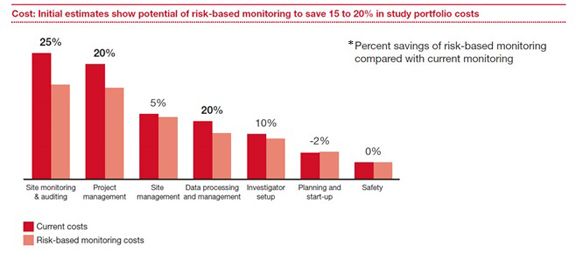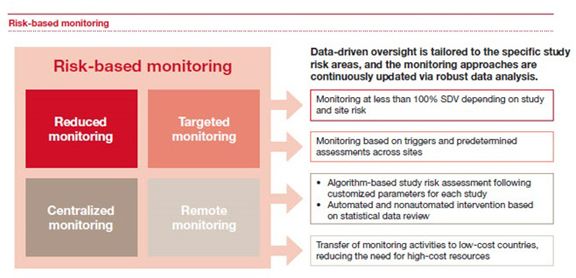Higher Quality at Lower Cost: The Benefits of Portfolio-Wide Predictive Analytics in Clinical Trial Monitoring
Although both the US Food and Drug Administration and the European Medicines Agency provided guidance on predictive analytics techniques in the development of a risk-based approach to the monitoring of clinical trials as far back as 2011, pharmaceutical and life science companies have been slow to fully adopt this approach across their study portfolios.
SPOTLIGHT EVENTRisk-Based Monitoring – Beyond Theory In-Depth ReviewMarch 13, 2014
Cambridge, MassachusettsDownload BrochureRegister
RELATED
- The Emergence of the Centralized Monitor
- Risk-Based Approaches
- ICON Exec Discusses ICONIK MonitoringMore in Risk-Based Monitoring
Although both the US Food and Drug Administration and the European Medicines Agency provided guidance on predictive analytics techniques in the development of a risk-based approach to the monitoring of clinical trials as far back as 20111, pharmaceutical and life science companies have been slow to fully adopt this approach across their study portfolios. The industry, for the most part, still links quality of data to the extent of monitoring and source document verification (SDV) and errs on the side of caution when following regulations2. But regulations don’t specify 100% SDV. They leave the quantity and type of monitoring up to researchers and sponsors3.
PricewaterhouseCoopers (PwC) has leveraged some of these predictive analytics methods to serve as a viable solution that addresses overarching clinical trial risks, such as:
- The identification of sites that are either not set up effectively or whose quality can be addressed even before the trial begins.
- The development of infrastructure and metrics that enable site/investigator performance tracking that allows sponsors and CROs to proactively intervene before the quality issue arises.
- Processes that enable study teams to react quickly to early quality issues, resulting in the rapid implementation of a quantifiable and trackable remediation plan that addresses the root cause of the quality issue.
Recent research and analysis by PwC found that broad adoption of risk-based monitoring could potentially increase overall trial patient safety and data integrity, with the ancillary benefit of an estimated 15%–20% savings in the total cost of the trial.

*Percentages based on PwC data and analysis
Traditional monitoring typically allocates resources equally among study sites, regardless of clinical data or the risk to patients. Routine visits to all clinical sites with 100% SDV (comparing all data points on every case report form to all subjects’ medical records4) are common — and are the largest cost driver in clinical trial budgets5.
Predictive analytics allows for sponsors to assess investigator risk and allocate monitoring resources where they are needed most. Real-time predictive modeling in the form of risk-based monitoring enables a study sponsor to adjust the level of monitoring as risk changes at individual sites.
Risk-based monitoring comes in many “flavors” but typically leverages four tiers of monitoring:
- Reduced monitoring: Monitoring less than 100% SDV, depending on protocol or site risk. Reduced monitoring relies on real-time data flow from such systems as interactive voice recognition (IVRS/IWRS), electronic data capture, clinical trial management, and central laboratories.
- Triggered monitoring: An additional level of risk management based on predefined triggers, such as data captured from monitoring site visit reports and IVRS/IWRS systems. For example, a limit of protocol deviations, screen fails, or lost to follow-up, if beyond or below a predefined threshold, could automatically trigger varying degrees of on-site or remote monitoring.
- Centralized monitoring: An integrated approach to assess risk and more appropriately allocate resources based on fixed and dynamic risks (see definitions below). Centralized monitoring, combined with statistical data analysis, can lead to automated and non-automated intervention in the study.
- Remote monitoring: Uses lower-cost resources to conduct off-site monitoring activities, such as investigator telephone calls and remote data analysis. PwC’s approach to risk-based monitoring takes this process further, using a combination of sourcing, low-cost countries, and flexible and remote-based employees. Remote monitoring supplements reduced on-site SDV to enable maintenance of patient safety and data integrity.

The backbone of risk-based monitoring is a series of predictive analytics methods that assigns tailored risk scores to each investigational site that is used to determine the appropriate mix and level of monitoring techniques. This score helps the trial sponsor decide on a customized monitoring strategy for each location. Because the strategy is based on real-time data, the sponsor can adjust it as site risk changes throughout the progression of a trial.
The algorithms use two types of risk as inputs: fixed and dynamic.
- Fixed risks are the protocol and site-level risks that remain constant throughout the trial. Typical protocol risks include the therapeutic area, target product profile, drug safety profile, and invasiveness of drug delivery. Study site risks include the experience of the investigator and staff, site location, number of study coordinators, and expected patient enrollment. Fixed risks also might include next-generation predictive modeling techniques based on non-traditional risk factors, such as investigator proximity to a university, investigator affiliation, number of simultaneous trials, and coordinator experience.
- Dynamic risks are those data points that vary throughout the trial and integrate into an algorithm’s real-time evaluation of risk as they change during the study. They include real-time enrollment rate; number of adverse events; number of protocol deviations; time to first patient, first visit; primary and secondary efficacy range; and site performance metrics.
Developing an analytics approach to monitoring
To begin developing an analytics approach to monitoring, a company must first investigate its data sources to identify risk identifiers, develop a risk algorithm around these risk identifiers and data flows that will feed into the algorithm, establish a governance structure, and identify pilots for the new operating model. As new trials begin, a company can gradually transition all of its therapeutic areas to risk-based monitoring. As the risk-based monitoring program develops, change management and communication will be essential to its success.
For the algorithm to work properly, the required data must flow into a centralized database. Companies pursuing an analytics approach to monitoring should evaluate current technologies in the clinical platform to identify gaps in the type of data they are collecting. Current technologies, vendor portals, and query tools will already be capturing some of the data points; however, other points will be missing, so technology will have to be adapted or developed to fill in the gaps.
Pharmaceutical companies and contract research organizations with broad risk profiles across their portfolios are expected to see the greatest cost savings in moving to a risk-based monitoring approach. Trials that typically yield the most significant savings are large phase II or III development studies with drug safety profiles that are mild to moderate. Studies with high safety-risk profiles, such as some oncology studies, may not see dramatic cost savings in moving to a risk-based monitoring approach, because heavy monitoring and patient evaluation are necessary throughout the course of these investigations.
Some companies are venturing into analytics and risk-based monitoring on a trial-by-trial basis. To reap the highest benefits, however, clinical trial sponsors should take a uniform approach, applying the method across their study portfolio.
These analytics methods, when thoroughly integrated into an R&D program on a portfolio-wide basis, can improve patient safety, increase data quality, shorten trials, and lower costs. This can free up additional funds for organizations to invest back into other R&D programs. In addition, trial monitors would benefit from risk-based monitoring by having a less hectic travel schedule while maintaining quality and productivity6.
Ultimately, this type of monitoring can deliver value to the healthcare system by speeding the development of safe and effective drugs at lower cost.
About the Authors
Robert Franco, Partner, PwC’s Pharmaceuticals and Life Sciences Industry Practice
Mark Hronec, Director, PwC’s Pharmaceuticals and Life Sciences Industry Practice
Brian Slizgi, Senior Associate, PwC’s Pharmaceuticals and Life Sciences Industry Practice
References
1FDA, “Guidance for Industry Oversight of Clinical Investigations — A Risk-Based Approach to Monitoring,” August 2011, http://www.fda.gov/downloads/Drugs/.../Guidances/UCM269919.pdf, and EMA, “Reflection paper on risk based quality management in clinical trials,” Aug. 4, 2011, http://www.ema.europa.eu/docs/en_GB/document_library/Scientific_guideline/2011/08/WC500110059.pdf.
2
Sourabh De, “Hybrid approaches to clinical trial monitoring: Practical alternatives to 100% source data verification,” Perspectives in Clinical Research, Jul-Sep 2011; 2(3): 100–104.
3ICH Good Clinical Practice, E6, 5.18.3, “Extent and Nature of Monitoring,” http://ichgcp.net/518-monitoring.
4 Sandra Hines, “Targeting Source Document Verification,” Applied Clinical Trials, Feb. 1, 2011, http://www.appliedclinicaltrialsonline.com/appliedclinicaltrials/article/articleDetail.jsp?id=706505&pageID=1&sk=&date=.
5 Institute of Medicine, Assuring Data Quality and Validity in Clinical Trials for Regulatory Decision Making: Workshop Report, Washington, DC: National Academies Press; 1999.
6 Sourabh De, “Hybrid approaches to clinical trial monitoring: Practical alternatives to 100% source data verification.”
Improving Relationships and Diversifying the Site Selection Process
April 17th 2025In this episode of the Applied Clinical Trials Podcast, Liz Beatty, co-founder and chief strategy officer, Inato, discusses a number of topics around site engagement including community-based sites, the role of technology in improving site/sponsor relationships, how increased operational costs are impacting the industry, and more.
Behind the Buzz: Why Clinical Research Leaders Flock to SCOPE Summit
February 7th 2025In this episode, we meet with Micah Lieberman, Executive Conference Director for SCOPE Summit (Summit for Clinical Ops Executives) at Cambridge Innovation Institute. We will dive deep into the critical role of collaboration within the clinical research ecosystem. How do we bring together diverse stakeholders—sponsors, CROs, clinical trial tech innovators, suppliers, patients, sites, advocacy organizations, investors, and non-profits—to share best practices in trial design, program planning, innovation, and clinical operations? We’ll explore why it’s vital for thought leaders to step beyond their own organizations and learn from others, exchanging ideas that drive advancements in clinical research. Additionally, we’ll discuss the pivotal role of scientific conferences like SCOPE Summit in fostering these essential connections and collaborations, helping shape the future of clinical trials. Join us as we uncover how collective wisdom and cross-industry partnerships are transforming the landscape of clinical research.
FDA-Approved Gene Therapy Beqvez Shows Sustained Efficacy, Safety in Long-Term Hemophilia B Trial
April 17th 2025Beqvez (fidanacogene elaparvovec), an FDA-approved one-time gene therapy for hemophilia B, demonstrated sustained factor IX expression, low bleeding rates, and a favorable safety profile over long-term follow-up.

